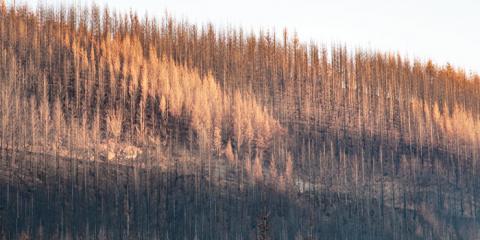How many trees were burned in the 2020 Labor Day fires, and do we still have more trees than we did 100 years ago?
February 17, 2021
In light of 2020’s devastating fire season, I was recently asked these two questions. To answer them, I turned to data published by the U.S. Forest Service’s Forest Inventory and Analysis program, or FIA, and employed a bit of creative math.
The 2020 Labor Day fires burned approximately 1 million acres of Oregon forestland. To estimate how many trees were burned in these fires, I needed an estimate of how many trees we had in Oregon before the fires, and how many trees per acre of forestland we have.
To estimate the number of trees killed in the Labor Day fires, I used an estimate of trees per acre (tpa) to go with our acreage estimate of 1 million acres. Table 18 from FIA’s Oregon’s Forest Resources, 2006–2015: Ten-Year Forest Inventory and Analysis Report gives us an estimate of 10.28 billion trees on Oregon forestland before the Labor Day fires, and Table 5 provides an estimate of 29.656 million total acres of forestland. Dividing the number of trees by the number of acres gives us an estimate of 347 trees per acre on Oregon forestland.
Combining this number with the estimate of 1 million acres burned in the 2020 fires, and assuming that the acres burned in a similar manner across the tree size classes, gives us an estimate of 347 million trees killed in the Labor Day fires. Using the estimate of 10.28 billion trees before the Labor Day fires and subtracting the estimated 347 million trees killed in those fires leaves an estimated 9.93 billion trees. That means the trees burned in the 2020 wildfires represent about 3.5% of the trees growing in Oregon.
Now that we’ve estimated how many trees we had before the fires, how many were killed in the fires, and thus how many trees we have left after the fires, we can figure out if we still have more trees than we did 100 years ago. To do this, we need to look at the amount of forestland in Oregon now versus 100 years ago, how the size distribution has changed over time, and how that has affected the number of trees.
Forest Resources of the United States estimates the total amount of forestland in various states over time. The closest estimate we have for total forest area in Oregon 100 years ago is 1920, when Forest Resources of the United States estimates we had approximately 30.3 million acres of forestland. Based on the report’s findings, we can see that in 2017 we had about 29.6 million acres of forestland, nearly 98% of the forestland area we had in 1920. Unfortunately, the only data we have for 1920 is an estimate of forest area. However, we do have excellent estimates of timber volume by state back to 1953, and estimates of net volume for regions by tree-diameter classes back to 1953. The forests of 1953 are not exactly the forests of 1920. However, the 1953 data says we had 30.3 million acres of forestland in Oregon – the same as the estimate for 1920.
Another helpful estimate from Forest Resources is the net volume of timber by tree-diameter classes and regions for 1953 through 2017. The relationship between diameter class and trees per acre allows us to estimate the number of trees in 1953 at 8.17 billion trees (I’ll spare you this math).
Although I’m unable to accurately estimate how many trees there were in Oregon 100 years ago, my conclusion is that there are many more trees in Oregon today than there were in 1953. In fact, my estimate is that we have about 1.76 billion more trees today than in 1953.
Now that I’ve done the math, I think it’s safe to say that we have upwards of 2 billion more trees in Oregon today than we did 67 years ago, even after losing nearly 350 million trees in the Labor Day fires. Some good news after such a rough fire season that had a devastating impact on our state’s forests and communities.
For the forest,
Mike Cloughesy
Director of Forestry
